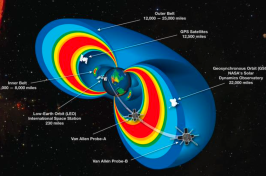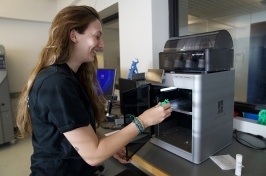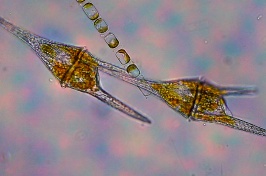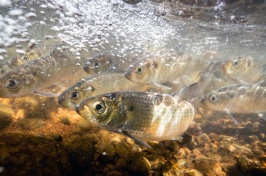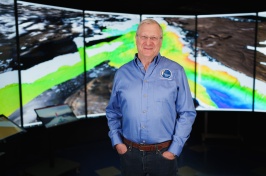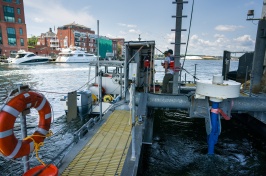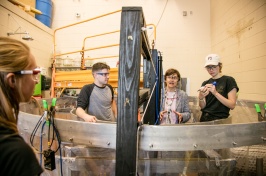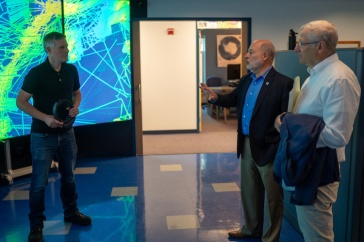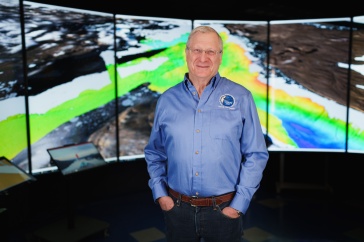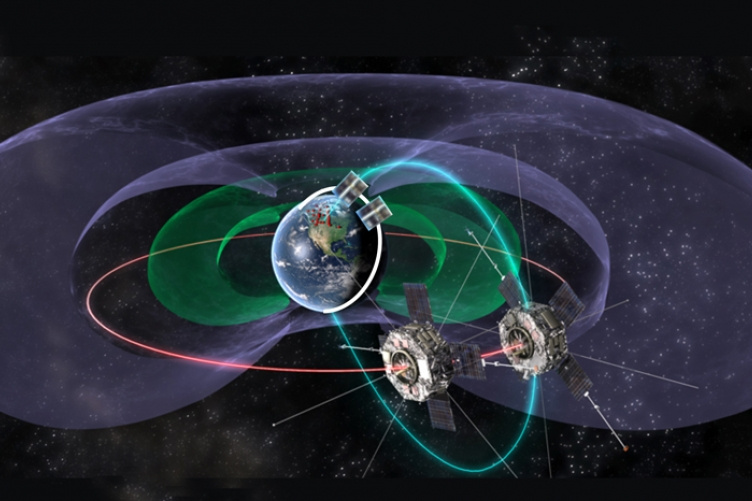
further out in the heart of the radiation belt region. (Background illustration courtesy of A. Kale, University of Alberta.)
Astrophysicist Harlan Spence, director of the UNH Institute for the Study of Earth, Oceans, and Space, is the university’s lead scientist, or “principal investigator,” on two NASA missions that are probing the mysterious inner workings of Earth’s high-energy radiation belts — the Van Allen Probes mission and the recently launched FIREBIRD-II "CubeSat" mission.
There is great synergy between the two missions: both are measuring aspects of the radiation belts, which can wreck havoc with space- and Earth-based communication systems; both comprise twin spacecraft to provide much needed temporal and spatial-scale measurements that cannot be obtained by a solitary spacecraft, and both started gathering science-grade data right out of the gate due to a bit of celestial serendipity — significant, unexpected solar activity that gave the belts a measureable jolt.
And both missions couldn’t be more different.
While the Van Allen Probes — formerly known as the Radiation Belt Storm Probes when launched in the summer of 2012 — took fully a dozen years from conceptual design to launch and cost $686M, the little 4x4x6-inch Focused Investigations of Relativistic Electron Burst Intensity, Range, and Dynamics, or FIREBIRD-II, CubeSats mission took about a year to bring to fruition following the 2013 launch of the first FIREBIRD spacecraft and cost $200K (the initial FIREBIRD mission cost $900K).
“The beauty of a targeted, low-cost mission,” Spence says of FIREBIRD-II “is that it’s not doing everything. Rather, we’re conducting one very focused investigation and going after a major physical unknown that will ultimately allow the Van Allen Probes to reach a more firm conclusion. The probes can’t really do what we’re doing with the tiny FIREBIRD-II mission.”
For comparison, think of a huge, and hugely expensive, ocean-going research vessel that plies the waters while its little remotely controlled vehicle fathoms below the surface boldly goes where the mother ship cannot.
The twin FIREBIRD-II CubeSats were launched January 31, 2015, as independent, auxiliary payloads on a Delta II rocket carrying NASA's Soil Moisture Active Passive mission satellite and are braving a region of space 400 miles above Earth to probe a mysterious physical process within our planet's dangerous radiation belts. Construction of the CubeSats was a collaboration between UNH and Montana State University.
That process, known as microbursts, involves electrons moving at nearly the speed of light during short-duration (100 milliseconds) events. Microbursts are thought to be one of the primary mechanisms by which the outer radiation belt loses energetic particles to Earth's atmosphere after the occurrence of powerful solar storms. Such storms can dramatically change the intensity of the radiation belts and thereby pose hazards to space-based technology.
"We care about this because the belts' high-energy particles, particularly the electrons, pose a real risk to spacecraft," says Spence, "so if we understand these physical processes that create ‘space weather’ better, we'll be able to predict how the radiation belts will behave and both protect the satellites we depend upon for telecommunications, weather monitoring and prediction and design them to withstand this high-energy radiation."
As luck would have it, shortly after the FIREBIRD-II spacecraft were launched a geomagnetic storm driven by the solar wind zapped the whole geomagnetic system and generated a radiation belt enhancement event — an occurrence Spence says couldn’t have been scripted better from a science perspective.
Luckier still, one of the goals of FIREBIRD-II was to have both spacecraft operating right out of the shoot in an effort to understand how conditions change over very short length scales — something the first FIREBIRD mission was unable to achieve for a variety of reasons.
Notes Spence, “Because the twins keep separating constantly over time, the early part of the mission is really important because they’re still pretty close together — less than 100 kilometers — so, literally only hours after launch we were getting very high-quality science data from both spacecraft, and in conditions that were very well suited for microbursts to be occurring.”
Nailing down when, why and how microbursts occur is critical because as the radiation belts ebb and flow in the wake of solar activity and ensuing input of high-energy particles, scientists can watch the belts come and go, and go up and down, but they don’t know where the particles driving this movement are coming from or going to.
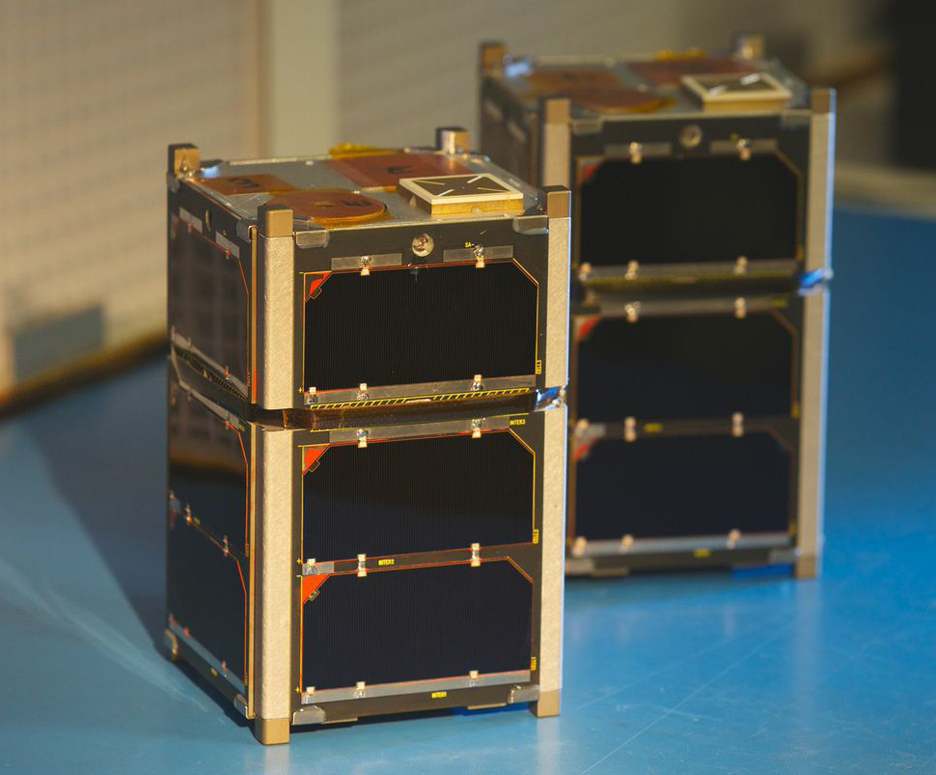 |
| The twin FIREBIRD-II CubeSats in final launch configuration. (Photo: NASA) |
And while the Van Allen Probes are in the right spot for most of the radiation belt science, in order to understand the loss of particles to the atmosphere you have to be in the right spot looking up and catching those particles raining down, which is precisely what FIREBIRD-II appears to be doing based on initial data analysis.
“The CubeSats will allow us to constrain a lot of things that right now are not well known and, among other things, will ultimately improve our modeling capabilities, which is important for the space weather aspect,” Spence says. “Because until you can quantify the loss processes you can’t really predict what the belt intensities will be out where spacecraft are orbiting — a region we worry about because of the intense radiation.”
The CubeSat program provides students with the opportunity to participate as never before in satellite missions end-to-end. UNH alumnus Alex Crew '14G, now a postdoctoral researcher at Stanford University, did the bulk of his doctoral work designing and implementing the science operations plan for the FIREBIRD mission and is involved in the science operations and science data analysis for FIREBIRD-II.
More info:
UNH Institute for the Study of Earth, Oceans, and Space
-
Written By:
Tracey Bentley | Communications and Public Affairs







